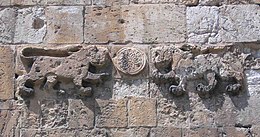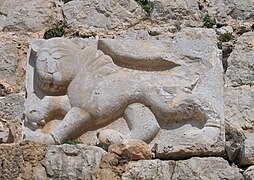金达斯桥
| 金达斯桥 | |
|---|---|
| جسر جنداس | |
 | |
| 坐标 | 31°58′07.51″N 34°54′00.78″E / 31.9687528°N 34.9002167°E |
| 承载 | |
| 跨越 | 阿亚隆干河 |
| 地点 | 以色列卢德 |
| 官方名称 | 卢德桥(希伯来语:גשר לוד) |
| 其他名称 |
|
| 设计参数 | |
| 桥型 | 拱桥 |
| 全长 | 30米 |
| 宽度 | 10米 |
| 历史 | |
| 开通日 | 公元1273年 |
| 地图 | |
 | |
金达斯桥(阿拉伯语:جسر جنداس,罗马化:Jisr Jindās),希伯来语称为卢德桥(希伯来语:גשר לוד,罗马化:Gesher Lod),别称拜巴尔桥(阿拉伯语:جسر بيبرس,罗马化:Jisr Baybars),是位于以色列卢德北出口的古代拱桥,建于公元1273年。该桥跨越阿亚隆干河,向南通往卢德和拉姆拉[1]。该桥得自1948年前位于桥东侧[2]的金达斯村[3],该村庄的历史或可追溯到1129年,当时的一份拉丁文特许状中提到了“金达斯的‘casal’”[4]。金达斯桥是苏丹拜巴尔一世在巴勒斯坦修建的最著名的桥梁,其他修建的桥梁还有伊卜奈桥和伊斯杜德桥[5]。
历史
[编辑]该桥建于伊斯兰历672年(公元1273年),但据信其地基早在罗马时期就已建立[6]。1896年,法国东方学家夏尔·西蒙·克莱蒙-加诺首次对该桥进行了现代研究。他指出,一篇阿拉伯编年史提到拜巴尔一世于公元1273年在拉姆利赫附近修建了两座具有重要意义的桥,以便其军队在埃及和叙利亚北部之间通行。两座桥中一座是本桥,另一座被认为是伊卜奈桥[7]。
莱蒙-加诺得出结论称,这座桥的石材取自圣乔治教堂的废墟,该教堂在十字军与阿尤布王朝战争中被摧毁[7]。
桥两侧的中央拱门上方都有一块长方形石板,上面刻有内容几乎相同的铭文,铭文两侧的面板上刻有狮子(或豹子)的图案。东侧的铭文如下:
奉至仁至慈的真主之名,愿真主保佑我们的主穆罕默德及其家人和同伴!这座圣桥是由我们的主人,伟大的苏丹马利克·扎希尔·鲁克-丁·拜巴尔,阿布德·穆塔利卜之子,在他的儿子苏丹王马利克·赛义德·纳西尔丁·巴雷凯·汗的时代下令修建的,愿真主颂扬他们的胜利,并赐予他们恩典。这是在渴望真主怜悯的卑微仆人阿拉丁·阿里·苏瓦格的指挥下进行的,愿真主在671年斋月宽恕他和他的父母。
بسم الله الرحمن الرحيم وصلواته على سيدنا محمد وعلى آله وصحبه أجمعين، أمر بعمارة هذا الجسر المبارك مولانا المعظم الملك الظاهر ركن الدين بيبرس ابن عبد الله في أيام ولده مولانا الملك (..) السعيد ناصر الدين بركة خان أعز الله أنصارهما وغفر لهما وذلك في بولاية العبد الفقير إلى رحمته الله علاء الدين السواق غفر الله له ولوالديه في شهر رمضان سنة أحد وسبعين
1882年,巴勒斯坦勘探基金的《巴勒斯坦西部调查》(Survey of Western Palestine)指出,这些雕塑和铭文似乎是撒拉森人的作品[8]。铭文中提到的阿拉丁·阿里·苏瓦格(Ala al-Din Ali al-Suwwaq)正是三年前负责监督卢德大清真寺建设的官员[9]。
18至19世纪期间,该桥是卢德分区的一条主要道路,该分区从南部的莫迪因马加比勒特向北延伸至埃尔阿德;从东部的山麓,穿过卢德谷一直延伸到西部的雅法郊区。该地区有大约20个村庄、数千居民,以及数万公顷的优质农田[10]。
设计
[编辑]金达斯桥长30多公尺,宽10米,为南北走向。它由三个拱门门和两个中央桥墩组成,中间的拱门比两侧的拱门更宽[1]。
雕塑
[编辑]拜巴尔将豹作为纹章,并将其刻在钱币和建筑物上,其原因可能是他的名字在其母语突厥语中意为“大豹”[11]。而金达斯桥铭文两侧的面板上印有一只在玩弄老鼠的狮子(一说是豹子),其中的老鼠可能象征着拜巴尔的十字军敌人[12]。
根据摩西·沙龙的说法,金达斯桥上的狮子与耶路撒冷狮子门和加沙城巴沙宫上的狮子相似,三者都代表着拜巴尔。与金达斯桥上的狮子不同的是,加沙城的狮子上刻有交错的线条,似乎想体现豹斑;但两处的狮子都有相似的轮廓。据沙龙估计,它们都完成于公元前1273年左右[13]。
参见
[编辑]参考文献
[编辑]- ^ 1.0 1.1 Petersen 2001,第183页.
- ^ Jindas. Zochrot. [2024-03-02]. (原始内容存档于2024-04-04) (英语).
- ^ Marom, Roy. Jindās: A History of Lydda's Rural Hinterland in the 15th to the 20th Centuries CE. Lod, Lydda, Diospolis. 2022-11-01, 1: 4–6 [2024-01-28]. (原始内容存档于2023-10-04).
- ^ Clermont-Ganneau 1896,vol.2, p. 117.
- ^ Petersen 2008,第297页.
- ^ O’Connor 1993.
- ^ 7.0 7.1 Clermont-Ganneau 1896,vol.2, pp.110–117.
- ^ Conder & Kitchener 1882,SWP II, pp. 264–265.
- ^ Petersen 2001,第184页.
- ^ Marom, Roy. Lydda Sub-District: Lydda and its countryside during the Ottoman period. Diospolis - City of God: Journal of the History, Archaeology and Heritage of Lod. 2022, 8: 103–136 [2024-02-03]. (原始内容存档于2023-04-15).
During much of the Ottoman period, the subdistrict of Lydda (Lod) was a large administrative unit that stretched from the present-day city of Modi'in in the south to the present-day city of Elad in the north; from the foothills in the east, through the Lod Valley to the outskirts of Jaffa in the west. This area was home to thousands of inhabitants in about 20 villages, who had at their disposal tens of thousands of hectares of prime agricultural land.
- ^ Heghnar Zeitlian Watenpaugh. The image of an Ottoman city: imperial architecture and urban experience in Aleppo in the 16th and 17th centuries. Brill. 2004: 198. ISBN 90-04-12454-3.
- ^ Niall Christie. Muslims and Crusaders: Christianity's Wars in the Middle East, 1095-1382, from the Islamic Sources. Seminar Studies first. Routledge. 2014: 121, Plate 8. ISBN 9781138022744.
Plate 8 jisr jindas, Lydda (Lod), Israel. Built by Baybars in 1273, panels flanking the inscription on this bridge bear his lion/panther blazon. On each panel the lion plays with a rat, possibly intended specifically to symbolize the sultan's Frankish enemies.
- ^ Sharon 2009,p. 58 and pl.6.
参考书目
[编辑]- Clermont-Ganneau, C.S. Le pont de Beibars à Lydda. Recueil d'archéologie orientale: Clermont-Ganneau, Charles. Paris: Ernest Leroux. 1888. (editio princeps)
- Clermont-Ganneau, C.S. [ARP] Archaeological Researches in Palestine 1873–1874, translated from the French by J. McFarlane 2. London: Palestine Exploration Fund. 1896.
- Conder, C.R.; Kitchener, H.H. The Survey of Western Palestine: Memoirs of the Topography, Orography, Hydrography, and Archaeology 2. London: Committee of the Palestine Exploration Fund. 1882.
- Marom, Roy. Jindās at Lydda's Entrance: A Cornerstone of the Study of the City's Rural Hinterland (1459 – 1948). Diospolis. 2021, 7: 9-43 [2024-03-02]. (原始内容存档于2023-04-11).
- Marom, Roy. Jindās: A History of Lydda's Rural Hinterland in the 15th to the 20th Centuries CE. Lod, Lydda, Diospolis. 2022, 1: 1-31 [2024-03-02]. (原始内容存档于2023-10-10).
- O’Connor, Colin. Roman Bridges. Cambridge University Press. 1993. ISBN 0-521-39326-4.
- Palmer, E.H. The Survey of Western Palestine: Arabic and English Name Lists Collected During the Survey by Lieutenants Conder and Kitchener, R. E. Transliterated and Explained by E.H. Palmer. Committee of the Palestine Exploration Fund. 1881.
- Petersen, Andrew. A Gazetteer of Buildings in Muslim Palestine (British Academy Monographs in Archaeology) 1. Oxford University Press. 2001 [2024-01-28]. ISBN 978-0-19-727011-0. (原始内容存档于2021-05-29).
- Petersen, Andrew. Bridges in Medieval Palestine. U., Vermeulen; K., Dhulster (编). Egypt and Syria in the Fatimid, Ayyubid and Mamluk Eras VI. Peeters. 2008: 291–307 [2024-01-28]. (原始内容存档于2021-12-01).
- Sharon, M. Corpus Inscriptionum Arabicarum Palaestinae, B-C 2. BRILL. 1999: 229 [2024-03-02]. ISBN 90-04-11083-6. (原始内容存档于2023-08-03).
From Ramlah the route continued to Ludd (Lydda) and over a bridge (near Jindas) to the north of the city built in 1273, up to the khan of Jaljulyah, built around 1325.
- Sharon, M. Corpus Inscriptionum Arabicarum Palaestinae, G 4. BRILL. 2009. ISBN 978-90-04-17085-8.



